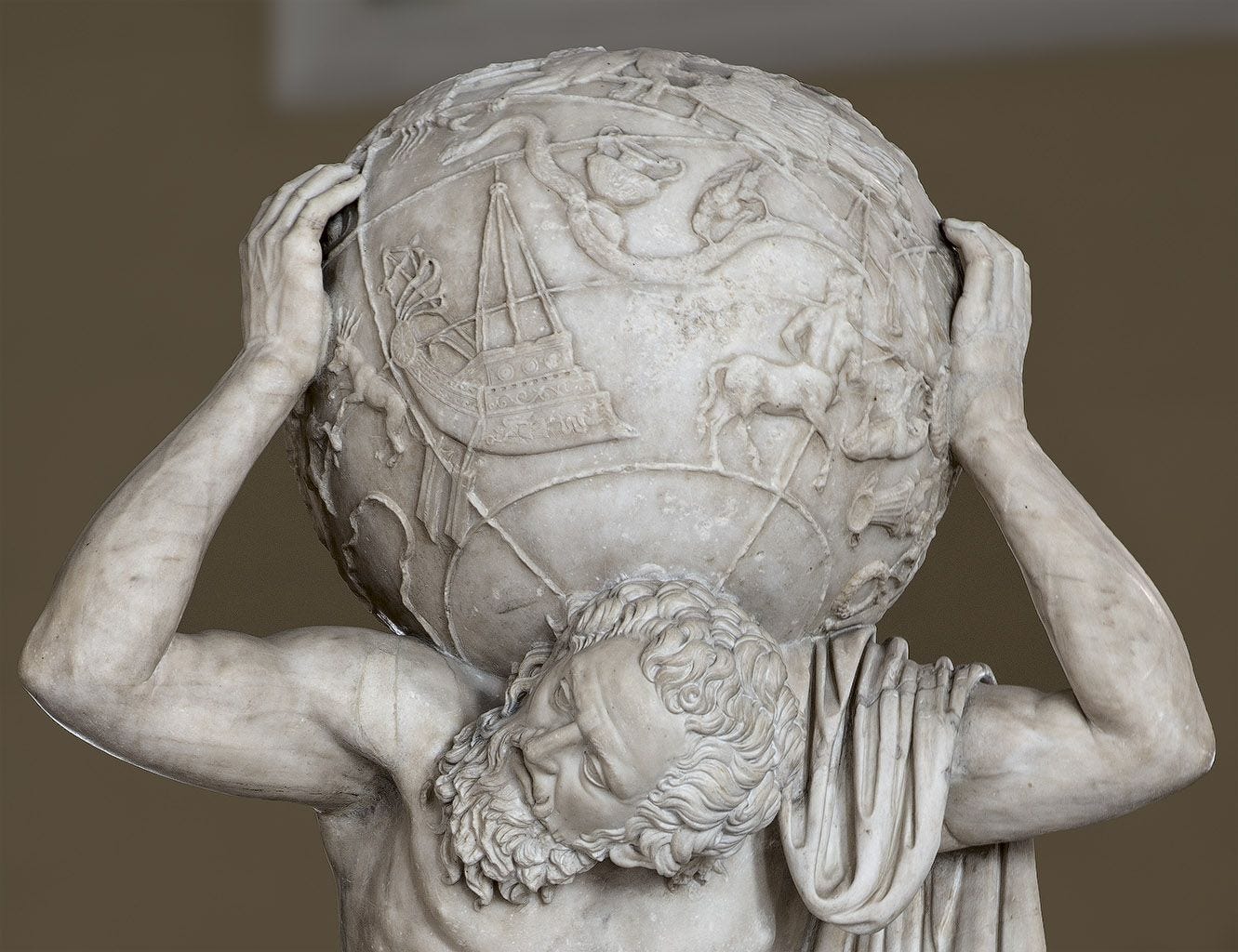Ancient Origins of Environmental Clickbait

Prove me wrong: this button marks a transformative moment in environmental media.
After digging through centuries worth of symbolism—from ancient Egypt to Earth Day’s 25th anniversary in 1995—the image above shows the first time the ‘hands holding Earth’ motif was ever used. As with any historical research, especially revolving around ‘original’ artistic ideas, records can be lost and truths buried. So, genuinely, I challenge you to uncover any earlier examples of this visual we’ve all come to recognize (and comment them on this article!)
The story of how this mainstream image emerged could be pruned down to a single, dull sentence. Activists interested in creating accountability for ecological protection designed a provocative symbol of humanity’s connection with Nature. But that would be a complete disservice to the rich history and societal evolutions that influenced how we visually portray Earth.
My research journey took me on a winding path through ancient civilizations; Medieval Times; the Enlightenment; the Space Age; and finally the advent of Earth Day. Join me on a quest through time as we uncover the true origins of this cultural iconography gesturing us to help save the planet.
Ancient Civilizations
The world’s greatest teachings are rooted in ancient wisdom, which can be translated through uncovered artifacts. Across ancient civilizations, the relationship between man and nature was one of complete submission. Unpredictable climatic forces had a massive influence on the most critical components of daily life—food, water, and housing—and science had not yet been invented (at least compared to our modern view of the subject) to predict or explain catastrophic events (e.g., drought, hurricanes, monsoons, earthquakes). Barring any other secular explanation, Earth was understood as a God in human form.
I initiated my quest for the origin of ‘hands holding Earth’ by examining how some of the oldest civilizations I could gather information on viewed and drew the environment—starting with ancient Egypt.
In northeast Africa, Earth was a god named Geb. Poised as an authoritative and powerful figure, his physical features represented features of the landscape. Geb was worshipped mainly by farmers and miners, whose livelihoods depended on the fruits of the land. The modern interpretation of Geb’s likeness stems from a tomb fresco in Egypt's Valley of the Kings (pictured below). You can see the Cosmic Father draped along the floor, forming a figurative birth canal for humanity with Nut, the sky goddess.
Ancient Egyptians saw Earth as a commanding, anthropomorphized God, which eventually translated into a resolve to respect and protect it.
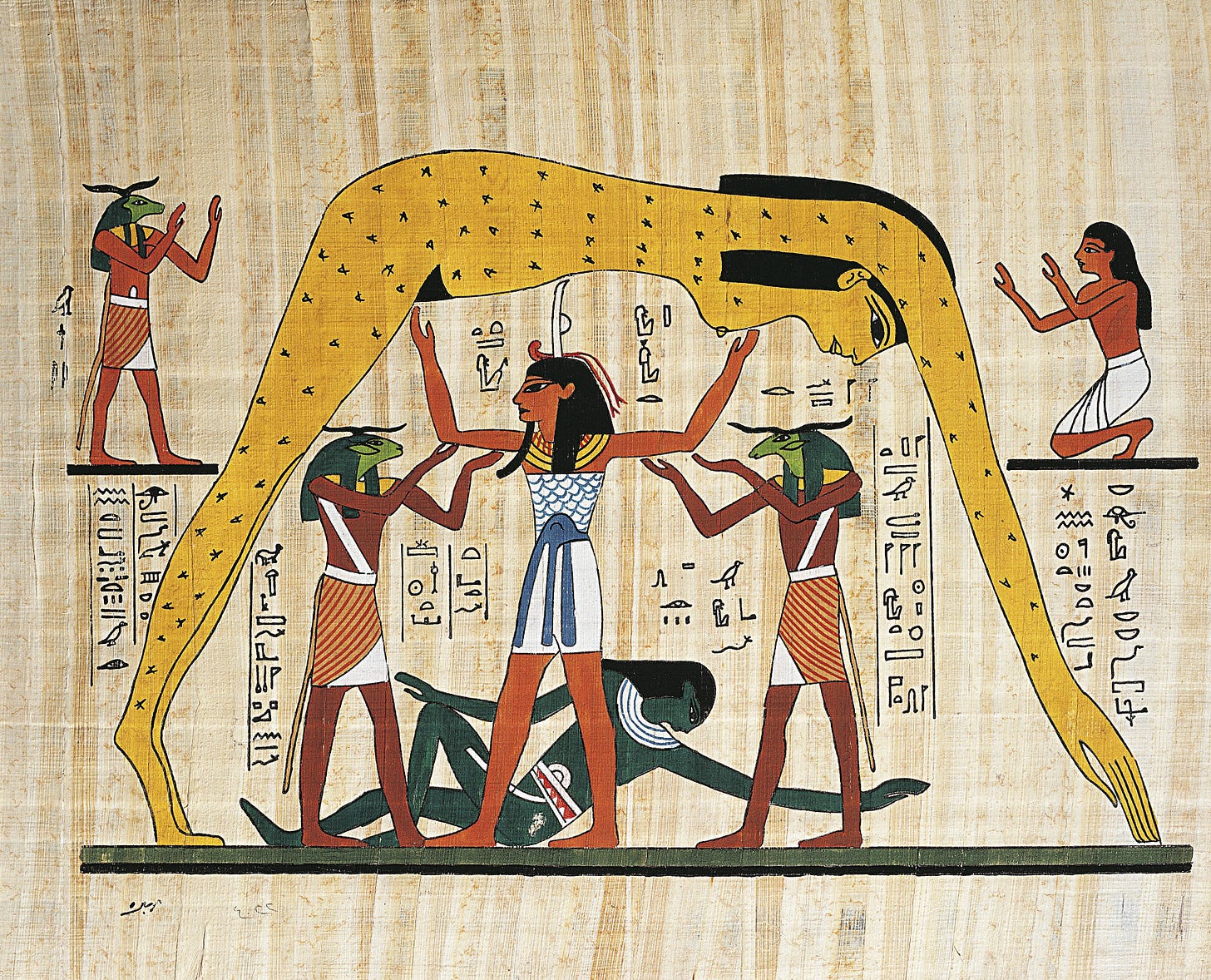
The Mayan civilization explained the entire universe as a giant Ceiba tree, which connects the underworld at the roots, Earth at the base, and Heaven at the limbs. As a farming society captivated by cosmology, most Mayan gods represented natural resources and celestial elements—though ironically the civilization collapsed due to a degraded environment, shrinking natural resource base, and changing climate.
The Maya emphasized the fragility of nature with respect to human extraction and in the context of the greater universe, which would influence future (particularly post-industrial) visualizations.
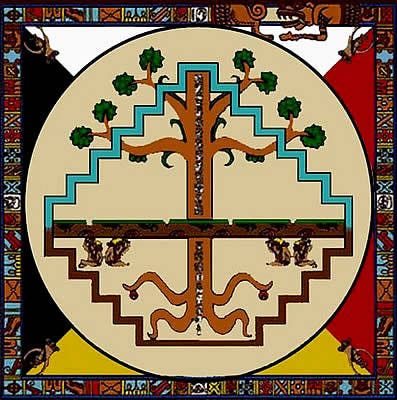
Ancient Chinese mythology is ripe with stories and drawings of how the world came to be. Despite the dominance of Daoism (a philosophy encouraging man to follow the direction of nature) during this era, many primordial creation myths demonstrated the critical role of human-like beings in separating Earth and Sky. The central figure Pan Gu was said to have forcefully split the two using his brute strength, even sacrificing his body to become the wind, stars, mountains, rivers, roads, and fertile land. He is also shown clutching the yin-yang (a symbol of complementarity and balance) in the recreation of a Chinese drawing below—which has some resemblance to the ‘hands holding Earth’ photo, only without the Earth.
The ancient Chinese have some of the earliest visuals of a universal sphere clutched by an immortal figure.

Another relevant element of Chinese mythology was the goddess of fertility and nature—NuWa. Being among the earliest (allegedly) matriarchal and matrilineal societies, the Chinese spearheaded the feminine illustration of Earth. NuWa is credited with creating humans and repairing Heavenly pillars holding up the sky using the legs of a giant turtle. Though an incredibly powerful one, the fact that Earth was now a woman was eventually reinforced as natural resources were increasingly exploited.
Ancient China initiated Earth as a feminine entity.
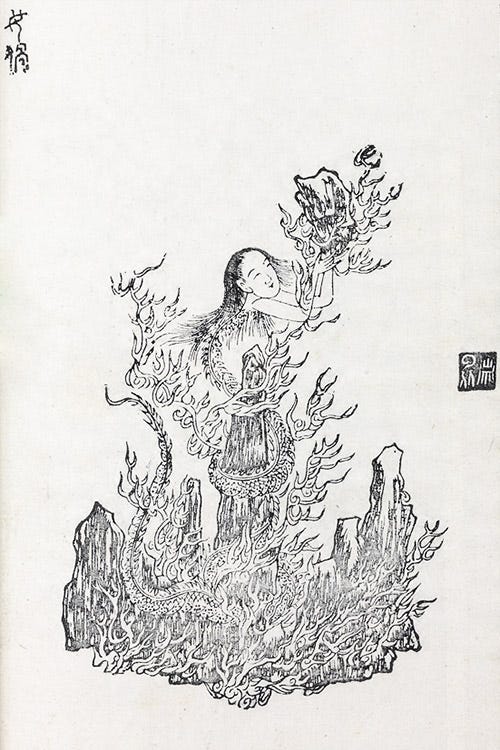
In Ancient Greek and Roman civilizations, Gaia (Terra Mater in Rome) was also a female goddess associated with fertility and abundance. Her respect as a provider and progenitor can be inferred from the following Homeric hymn:
“To Gaia the Mother of All. I will sing of well-founded Gaia, mother of all, eldest of all beings. She feeds all the creatures that are in the worlds, all that go upon the goodly land, and all that are in the paths of the seas, and all that fly: all these are fed of her store. Through you, O queen, men are blessed in their children and blessed in their harvests, and to you it belongs to give means of life to mortal men and to take it away.” -Greek Epic 7th - 4th B.C.
In AD 150, the Farnese Atlas was sculpted of a Greek Titan called Atlas carrying the celestial sphere (the heavens). The piece is thought to be a Roman recreation of an older Greek statue, and its meaning has continued to evolve to symbolize the burden of supporting the world on one’s shoulders. While the Romans are thought to have discovered the roundness of the Earth, this sculpture was still focused on the heavenly sphere.
Ancient Rome reasserted the symbol of a Divine figure carrying a spherical entity, which was later reinterpreted as planet Earth.
Medieval Era
Between the fifth and fifteenth centuries, organized religion became a staple in European daily life—not to mention ammunition for persecution, war, and the construction of new cathedrals. The rise of Christianity offered a note of faith during ‘the Dark Ages’ which infiltrated the art scene, resulting in many paintings and sculptures depicting Jesus Christ and other biblical imagery. Jesus was a protector of Earth, so some of the first modern paintings showed a Divine person ‘holding the world’ as a symbol of his dominion. You’ll notice, though, that because the ‘zoomed out version’ of Earth was completely unknown, the world is shown as a crystal ball.
During the Enlightenment, we saw a religious rendition of a spherical world held in Divine human’s hands.
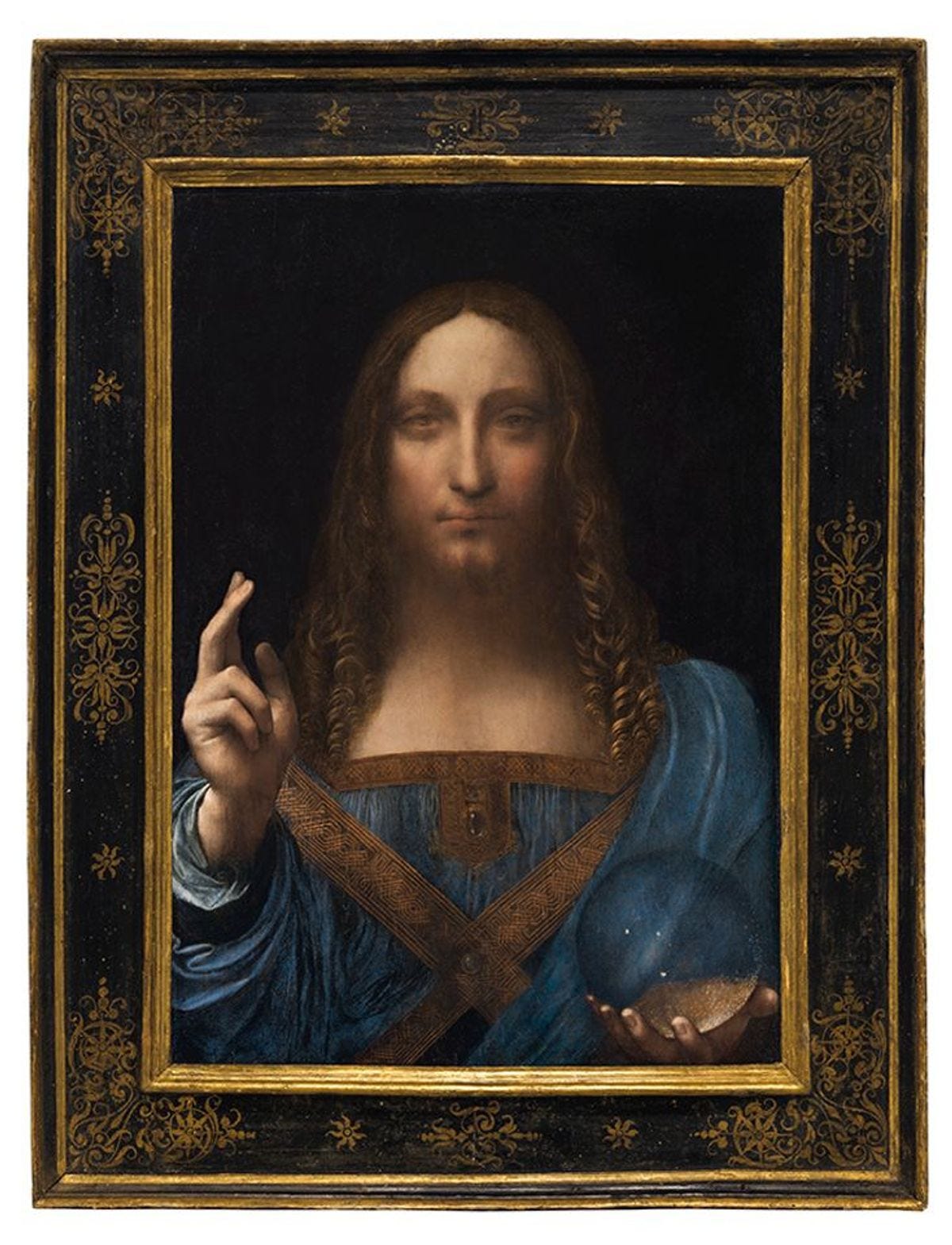
‘Enlightenment’
In the 19th century, with the rise of nationalism and imperialism, sculptors and architects incorporated figures holding globes or symbols of the Earth into public monuments and architectural designs. These sculptures often conveyed themes of national pride, conquest, or ideas spreading across the globe. ‘Progress of Civilization,’ a marble sculpture which has lived above the Senate Doors on the East Front of the Capitol since 1863, shows how the globe was used for political rather than pious purposes. A figure (thought to be Secretary of Treasury, James Guthrie) rests their hand on a globe and points to a faint continental outline. This piece was created in lockstep with transformational agreements in international trade—signifying the rising importance of the ‘global’ economy.
During the Enlightenment, the spherical world was secularized and used to demonstrate human conquest over Earth and its territories.

Space Age
With the scientific revolution and rise of globalization, Earth imagery shifted from ideological and/or religious in nature to explicitly human-centered. Thus far into our tens of centuries of investigation, we have seen several examples of human-like figures carrying Earth-like spheres, but none of them were astrologically accurate or environmentally inclined. The Space Age changed that.
In the 1960s, we learned what the Earth looked like from space. Powerful photos such as Earthrise and Pale Blue Dot gave us an accurate realization of Earth as a “universal crumb.”
Actual photos of the Earth first captured during the Space Age provided an accurate visualization of Earth and an understanding of the fragility of the world.
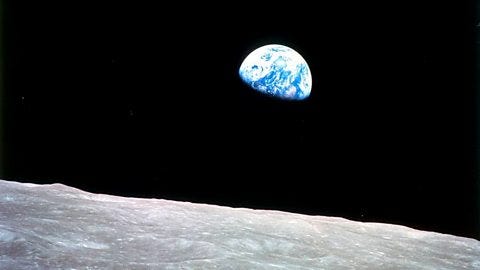

Earth Day
Space exploration coincided with the environmental revolution, focused on the preservation of land and natural resources from human impact. Shortly thereafter, the first Earth Day was created by Senator Gaylord Nelson as a way to force accountability of the industrial complex onto the national agenda—using the campaign ‘Give Earth a Chance.’ That same year, the US EPA was created and took charge leading Earth Day efforts thereafter.

Ten years later, they developed the first image included in this post—the most direct origin of the ‘hands holding Earth’ motif that I could get my hands on. This visual stuck around through the 90s, demonstrated by ‘The Earth is in Your Hands” campaign and Earth Day postage stamps below. And it continues to be a universal icon to this day.
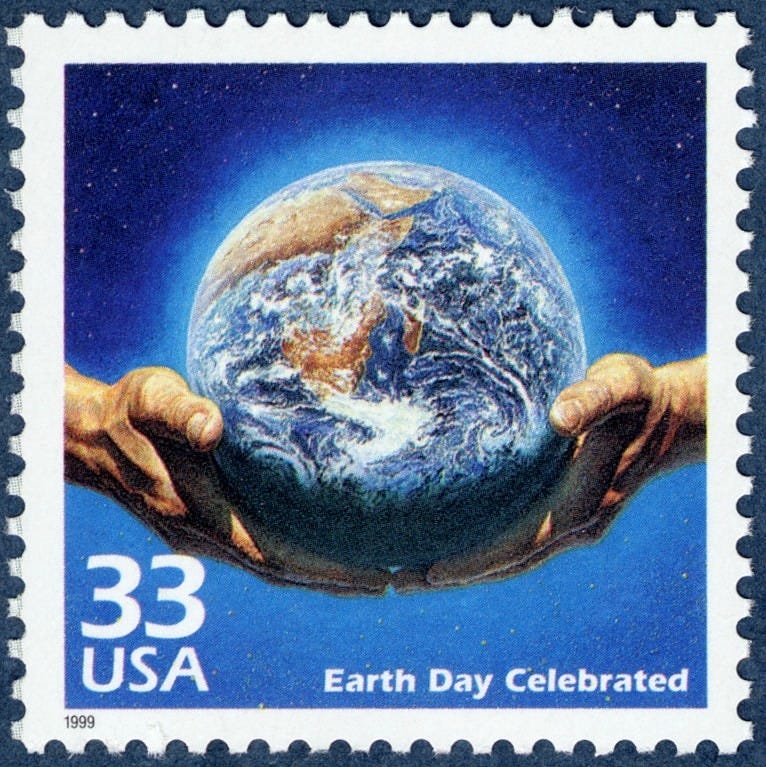
Having gone through the eras with me, I hope you can now appreciate the centuries-worth of co-evolution between human society and the environment that resulted in ‘hands holding Earth.’ In summary, the following points of divergence are important when considering how Earth is depicted today:
Ancient beliefs about the ethereal powers of Nature were overcome by Christian beliefs of God’s power over nature.
Feminization of Earth occurred as reciprocity with nature subsided, ushering human (particularly male) domination.
The age of European imperialism and enlightenment secularized the planet as a vector for colonization and global economic trade.
Astronomical revolutions provided an accurate view of what the Earth actually looked like.
The rise of environmentalism ushered human compassion and action around preserving our ecosystems, leading to national campaigns such as Earth Day that brought together advocates and artists, resulting in images like this.
If you’re curious about the origins of any other environmental imagery, messaging, or motif, let me know in the comments below!
P.S. As a sustainability buff, I know this space is surely siloed and constantly evolving. All to say, I welcome your fact-checking and feedback! Working together to improve our collective understanding of sustainability is the goal of my page!
P.P.S. The views in this article are my personal perspectives and do not necessarily reflect the view of my employer or any other person or entity.
Subscribe to my Substack.
Book a call with me to talk climate communications.
Connect with me on LinkedIn.



